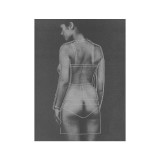The aim of this research was to explore how the body influences the construction logic of the structures that surround it and it inhabits. It starts with the concept of somatics and the relationship among body, clothing and architecture that exists on multiple levels. One of them exists in terms of geometry and the composition of details and proportions on the human body. By making both clothes and buildings, the creator designs and draws lines based on their relationship with the body and its movements and behaviors.
In the context of understanding how clothes are constructed ,how these lines are written and what is their relationship to the human body, the practice of creating (sewing)patterns was explored. It is a complex process that can be accomplished either empirically or with precise mathematical procedures. An original idea has to become reality through two-dimensional designs which will be assembled to compose a three-dimensional object, that the human body will inhabit. The main way for the flat fabric to acquire a three-dimensional form(in order to follow the complex topography of the human body), is the dart. Darts are created when the fabric is folded into a triangle and, with the excess fabric hidden, the desired curve is created.
To conclude, a pattern allows for an idea to be translated into an object. Designing patterns is a technical but also creative process. With this in mind, I tried to use the dart as a means to translate the pattern(the construction logic behind the implementation of an idea)into a conceptual object. Thus, the «diagram-form» presented in the last chapter was designed. Its means of construction, the darts, are exposed in order to identify their characteristics and the fact that they influence the development of the design and the form and shape that the final object will have.
